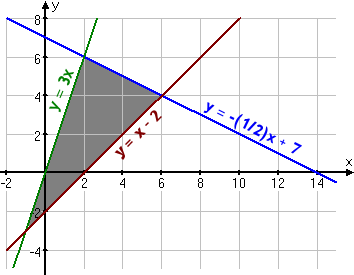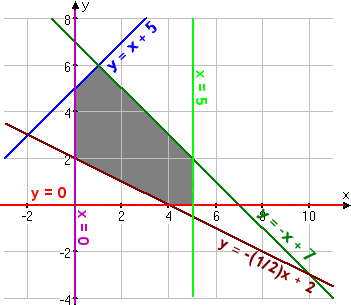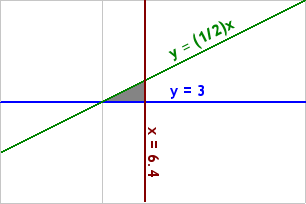Sections: Optimizing linear systems, Setting up word problems
INTRODUCTION:
In "real life", linear programming is part of a very important area of mathematics called "optimization techniques". This field of study (or at least the applied results of it) are used every day in the organization and allocation of resources. These "real life" systems can have dozens or hundreds of variables, or more. In algebra, though, you'll only work with the simple (and graphable) two-variable linear case.
The general process for solving linear-programming exercises is to graph the inequalities (called the "constraints") to form a walled-off area on the x,y-plane (called the "feasibility region"). Then you figure out the coordinates of the corners of this feasibility region (that is, you find the intersection points of the various pairs of lines), and test these corner points in the formula (called the "optimization equation") for which you're trying to find the highest or lowest value.
|
|
|
|
|
|
- Find the maximal and minimal value of z = 3x + 4y subject to the following constraints:
- Given the following constraints, maximize and minimize the value of z = –0.4x + 3.2y.

My first step is to solve each inequality for the more-easily graphed equivalent forms:


|
y
= –( 1/2 )x
+ 7y
= 3x
|
y
= –( 1/2 )x
+ 7y
= x
– 2
|
y
= 3x
y = x – 2 |
|
–( 1/2
)x
+ 7 = 3x–x
+ 14 = 6x14
= 7x
2 = x
y
= 3(2) = 6
|
–( 1/2
)x
+ 7 = x
– 2
–x + 14 = 2x – 4 18 = 3x 6 = x
y
= (6) – 2 = 4
|
3x
= x
– 2
2x = –2x = –1
y
= 3(–1) = –3
|
|
corner point at
(2, 6)
|
corner point at (6,
4)
|
corner pt. at (–1,
–3)
|
Somebody really smart proved that, for linear systems like this, the maximum and minimum values of the optimization equation will always be on the corners of the feasibility region. So, to find the solution to this exercise, I only need to plug these three points into "z = 3x + 4y".
- (2, 6): z
= 3(2) + 4(6) = 6 + 24 = 30
(6, 4): z = 3(6) + 4(4) = 18 + 16 = 34
(–1, –3): z = 3(–1) + 4(–3) = –3 – 12 = –15
and the minimum of z = –15 occurs at (–1, –3).



|
y
= –x
+ 7y
= x
+ 5
|
y
= –x + 7x = 5
|
x
= 5y
= 0
|
|
–x
+ 7 = x
+ 5
2 = 2x 1 = x
y
= (1) + 5 = 6
|
y
= –(5) + 7 = 2
|
[nothing to do]
|
|
corner at
(1, 6)
|
corner at (5,
2)
|
corner at (5,
0)
|
|
|
|
y
= 0y
= –( 1/2 )x
+ 2
|
y
= –( 1/2 )x
+ 2x
= 0
|
x
= 0y
= x
+ 5
|
|
–( 1/2
)x + 2 = 0
2 = (1/2)x 4 = x |
y
= –( 1/2 )(0) + 2
y = 0 + 2 y = 2 |
y
= (0) + 5 = 5
|
|
corner at
(4, 0)
|
corner at
(0, 2)
|
corner at
(0, 5)
|
- (1, 6): z =
–0.4(1) + 3.2(6) = –0.4 + 19.2 = 18.8
(5, 2): z = –0.4(5) + 3.2(2) = –2.0 + 6.4 = 4.4
(5, 0): z = –0.4(5) + 3.2(0) = –2.0 + 0.0 = –2.0
(4, 0): z = –0.4(4) + 3.2(0) = –1.6 + 0.0 = –1.6
(0, 2): z = –0.4(0) + 3.2(2) = –0.0 + 6.4 = 6.4
(0, 5): z = –0.4(0) + 3.2(5) = –0.0 + 16.0 = 16.0
Given the inequalities, linear-programming exercise are pretty straightforward, if sometimes a bit long. The hard part is usually the word problems, where you have to figure out what the inequalities are. So I'll show how to set up some typical linear-programming word problems.
- At a certain refinery, the refining process requires the production of at least two gallons of gasoline for each gallon of fuel oil. To meet the anticipated demands of winter, at least three million gallons of fuel oil a day will need to be produced. The demand for gasoline, on the other hand, is not more than 6.4 million gallons a day. If gasoline is selling for $1.90 per gallon and fuel oil sells for $1.50/gal, how much of each should be produced in order to maximize revenue?
The question asks for the number of gallons which should be produced, so I should let my variables stand for "gallons produced".
|
|
ADVERTISEMENT
|
|
|
|
- x:
gallons of gasoline producedy:
gallons of fuel oil produced
Since I have to have at least two gallons of gas for every gallon of oil, then x > 2y.
For graphing, of course, I'll use the more manageable form "y < ( 1/2 )x".
The winter demand says that y > 3,000,000; note that this constraint eliminates the need for the "y > 0" constraint. The gas demand says that x < 6,400,000.
I need to maximize revenue R, so the optimization equation is R = 1.9x + 1.5y. Then the model for this word problem is as follows:
- R = 1.9x +
1.5y, subject to:
x > 0
x < 6,400,000 Copyright © Elizabeth Stapel 2006-2011 All Rights Reserved
y > 3,000,000
y < ( 1/2 )x


No comments:
Post a Comment